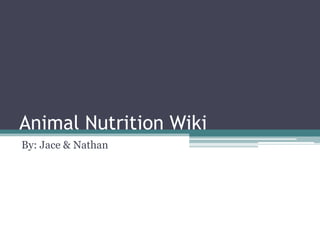
Animal Nutrition Wiki
- 1. Animal Nutrition Wiki By: Jace & Nathan
- 2. Nutrition Definition- Process in which animals consume and utilize food. Provides a balanced diet and supports the life processes of the animal. A direct correlation between proper nutrition and weight of grain, also known as feed efficiency.
- 3. Feed Efficiency Livestock Producers Monitor animal nutrition to decreases the number of days to slaughter. Companion Animal Limit amount of feed to maintain animal health.
- 4. Balanced Ration Goal is to provide animal with all nutrients needed for proper growth. Total amount of feed the animal gets in one day.
- 5. The Essential Nutrients Needed to insure life and provide energy. Without, problems may occur during Reproduction Lactation Body mass Maturity time 6 Essential Nutrients: Water Carbohydrates Lipids(Fats) Proteins Minerals Vitamins
- 6. Water Vital process where it dissolves nutrients and acts as a carrier of nutrients within the body. Also controls the body temperature of the animal. Makes up 40-80% of the animals nutrition. A clean water supply is best for rapid growth and efficient production. Younger animals need up to 80-90% of water which makes it THE MOST IMPORTANT NUTRIENT!
- 7. Carbohydrates This nutrient is the main energy source. Produces body heat while providing energy to the body. Carbohydrates have two groups, simple and complex. Simple contain things such as sugars and starches. Complex contain cellulose and fiber. The extra carbohydrates that aren’t burned off turn into fat. Obtained by: alfalfa, corn, sugars, and pasture.
- 8. Lipids(Fats) Provide twice as much energy and heat than carbohydrates. This nutrient is easily digested. Obtained by: oats, cotton seeds, and distiller grains.
- 9. Protein The main source of repairingand maintaining bodily functions. Such as hair, skin, muscles Essential for fetal development. Made by amino acids. Monogastric animals have to take in amino acids whereas Ruminants make their own. Obtained by: meat and bone meal, soybean meal, and corn meal.
- 10. Minerals Provide rapid growth of bones, teeth, tissue, and etc. These regulate chemical processes while making body functions happen. There are two types of minerals, macro and micro minerals. Macro minerals are needed in large amounts, whereas micro are needed in small. Obtained by: mineral supplements, wheat, and hay.
- 11. Vitamins Supplies animals with important nutrients that help repair and perform other body functions. These are needed in small amounts, but are very helpful to the animals. Two types of Vitamins are fat-soluble and water-soluble. Obtained through supplements.
- 12. 5 Different Diets Maintenance Growth Reproduction Lactation Work
- 13. Maintenance Used in animals in which weight maintenance is wanted. High in carbs and fat, low in protein, minerals, and vitamins.
- 14. Growth Used when you want animal to fatten or gain weight. Use many vitamins, minerals, protein.
- 15. Reproduction Used for animals from breeding to birth. High in protein, vitamins, and minerals. Feeding more than one animal.
- 16. Lactation All mammals after birth, produce milk. Fats, proteins, calcium, and phosphorous are needed.
- 17. Work Used for animals that are being grown for labor. Salt, minerals, carbs, and vitamins are needed to keep animals healthy.